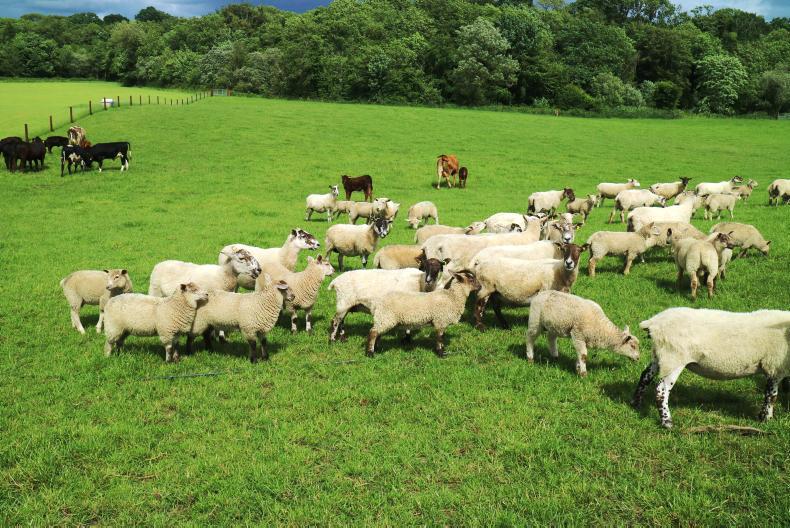Like many parts of the country, the Irish Farmers Journal Tullamore Farm has been eagerly waiting for this week’s rainfall. Grass growth rates reduced to 32kg DM/ha last week, a fall of 33kg DM/ha from the preceding week. The three weeks prior to this growth rates exceeded 100kg DM/ha so there has been big changes over a short period.
The slowdown in growth rates and the fact that there was a high volume of surplus paddocks taken out of the rotation has left grass supplies finely balanced with demand. However, growth rates are likely to pick up again following rainfall and this should hopefully leave the farm in a good position, with high-quality regrowth coming back on stream.
Grass quality has also been hard to maintain in recent weeks, with swards coming under pressure due to a lack of moisture. This has resulted in a higher percentage of stem developing and swards heading out much quicker. The lower growth rates have been balanced to a small extent by excellent utilisation and manager Shaun Diver is trying to achieve the best balance between grazing out swards and moving on animals before there is any negative impact on animal performance.
Mixed grazing of cows with calves at foot and ewes and lambs is delivering in this regard.

Shaun says swards are being grazed off more evenly and a single strip wire is being used in the two main grazing groups to allow ewes and lambs and calves to graze ahead of cows. Shaun also comments that grazing of ewes in the Cloonagh out-farm block is also delivering greatly in helping swards to thicken up. A bag of 18-6-12 is being applied to swards with a soil fertility deficit after grazing and surplus paddocks which have been taken out of the rotation and baled are also receiving a bag of 18:6:12 to replenish soil potassium and phosphorus levels.
Current performance
The last update on the sheep system in the paper was included midway through lambing. Weather remained a significant challenge right through the lambing period and into early lactation. There were no ewes released outdoors suckling triplet lambs, with surplus lambs sold or cross fostered. The litter size of 2.16 lambs per ewe joined did not deliver much of an opportunity to cross-foster and, as such, a total of 35 lambs were sold.
The lamb count at the first dose for nematodirus was 292 lambs at grass or an average of 1.72 lambs per ewe joined. Lamb mortality is running at about 10%, with the highest mortality recorded in lambs born as a triplet or quadruplet birth. While lamb mortality was relatively good considering the difficult weather conditions, ewe morality was high, with 11 ewes lost since lambing.
The greatest issue was grass tetany. The farm had experienced issues with tetany in the suckler herd in 2017 following a high percentage of the farm being freshly reseeded and slurry and compound fertilisers being applied in high quantities to address soil fertility deficits.
With this in mind, precautions were put in place to try to counteract the problem in the sheep flock. Meal was fed to ewes at 0.5kg to 0.8kg per head in early lactation and this also served to extend grass supplies, while high-magnesium buckets were offered once ewes were turned outdoors. This approach seemed to have worked but a week after meal feeding was ceased three ewes were lost in one batch after poor weather on one particular night, with two more lost a week later. There were two ewes lost to mastitis while a couple more ewes contracted mastitis but survived. There was one case of a ewe dying from bloat while three deaths were unexplained.
Lamb lameness
Shaun says the biggest challenge in the last two to three weeks has been addressing lameness caused by scald in lambs. Lambs were foot-bathed a number of times in recent weeks and will be foot-bathed again this week in a solution of zinc or copper sulphate. One of these treatments coincided with lambs receiving a clostridial disease vaccine, worm drench and cobalt B12 mineral drench and CLiK pour-on to protect against blowfly strike.
This week’s foot-bathing will coincide with the collection of faecal egg counts to determine the need to dose lambs while a selection of lambs will also be weighed to record performance. The average lambing date was the first week of April, meaning that ewes are currently in about week 11 of lactation. The target weaning date for the first batch of lambs born is fast approaching at the start of July.

Lambs are generally performing well but there is a mix in quality with some progeny displaying more hill genetics from the Mule ewe.
Second cut silage
Swards with a cover of grass are coping better with low rainfall levels, with second-cut silage starting to push on. There are 70 acres (38.3ha) closed and they received 2,000 gallons of cattle slurry per acre, two bags of 18:6:12 and a bag of CAN. The plan is to target a bulky second cut with the first cut focusing primarily on quality.
Grazing infrastructure
Mixed grazing of the suckler herd and sheep flock has required a few changes to grazing and fencing infrastructure. Two strands of electric wire were in place in much of the Cloonagh land block. A section of wire along a farm roadway that is most at risk to animals breaching during herding/flocking has been replaced with sheep wire and one strand of electric wire while two more strands of electric wire have been erected in places between swards and on some boundaries. Shaun says the electric wire is generally working well in holding sheep although there are a few ewes taking longer to settle and targeting gateways where there is more give in wire from spring-loaded gate handles.
Read more
Sheep management: grassland challenges and lamb castration
Sheepwatch: lamb prices remain firm
Like many parts of the country, the Irish Farmers Journal Tullamore Farm has been eagerly waiting for this week’s rainfall. Grass growth rates reduced to 32kg DM/ha last week, a fall of 33kg DM/ha from the preceding week. The three weeks prior to this growth rates exceeded 100kg DM/ha so there has been big changes over a short period.
The slowdown in growth rates and the fact that there was a high volume of surplus paddocks taken out of the rotation has left grass supplies finely balanced with demand. However, growth rates are likely to pick up again following rainfall and this should hopefully leave the farm in a good position, with high-quality regrowth coming back on stream.
Grass quality has also been hard to maintain in recent weeks, with swards coming under pressure due to a lack of moisture. This has resulted in a higher percentage of stem developing and swards heading out much quicker. The lower growth rates have been balanced to a small extent by excellent utilisation and manager Shaun Diver is trying to achieve the best balance between grazing out swards and moving on animals before there is any negative impact on animal performance.
Mixed grazing of cows with calves at foot and ewes and lambs is delivering in this regard.

Shaun says swards are being grazed off more evenly and a single strip wire is being used in the two main grazing groups to allow ewes and lambs and calves to graze ahead of cows. Shaun also comments that grazing of ewes in the Cloonagh out-farm block is also delivering greatly in helping swards to thicken up. A bag of 18-6-12 is being applied to swards with a soil fertility deficit after grazing and surplus paddocks which have been taken out of the rotation and baled are also receiving a bag of 18:6:12 to replenish soil potassium and phosphorus levels.
Current performance
The last update on the sheep system in the paper was included midway through lambing. Weather remained a significant challenge right through the lambing period and into early lactation. There were no ewes released outdoors suckling triplet lambs, with surplus lambs sold or cross fostered. The litter size of 2.16 lambs per ewe joined did not deliver much of an opportunity to cross-foster and, as such, a total of 35 lambs were sold.
The lamb count at the first dose for nematodirus was 292 lambs at grass or an average of 1.72 lambs per ewe joined. Lamb mortality is running at about 10%, with the highest mortality recorded in lambs born as a triplet or quadruplet birth. While lamb mortality was relatively good considering the difficult weather conditions, ewe morality was high, with 11 ewes lost since lambing.
The greatest issue was grass tetany. The farm had experienced issues with tetany in the suckler herd in 2017 following a high percentage of the farm being freshly reseeded and slurry and compound fertilisers being applied in high quantities to address soil fertility deficits.
With this in mind, precautions were put in place to try to counteract the problem in the sheep flock. Meal was fed to ewes at 0.5kg to 0.8kg per head in early lactation and this also served to extend grass supplies, while high-magnesium buckets were offered once ewes were turned outdoors. This approach seemed to have worked but a week after meal feeding was ceased three ewes were lost in one batch after poor weather on one particular night, with two more lost a week later. There were two ewes lost to mastitis while a couple more ewes contracted mastitis but survived. There was one case of a ewe dying from bloat while three deaths were unexplained.
Lamb lameness
Shaun says the biggest challenge in the last two to three weeks has been addressing lameness caused by scald in lambs. Lambs were foot-bathed a number of times in recent weeks and will be foot-bathed again this week in a solution of zinc or copper sulphate. One of these treatments coincided with lambs receiving a clostridial disease vaccine, worm drench and cobalt B12 mineral drench and CLiK pour-on to protect against blowfly strike.
This week’s foot-bathing will coincide with the collection of faecal egg counts to determine the need to dose lambs while a selection of lambs will also be weighed to record performance. The average lambing date was the first week of April, meaning that ewes are currently in about week 11 of lactation. The target weaning date for the first batch of lambs born is fast approaching at the start of July.

Lambs are generally performing well but there is a mix in quality with some progeny displaying more hill genetics from the Mule ewe.
Second cut silage
Swards with a cover of grass are coping better with low rainfall levels, with second-cut silage starting to push on. There are 70 acres (38.3ha) closed and they received 2,000 gallons of cattle slurry per acre, two bags of 18:6:12 and a bag of CAN. The plan is to target a bulky second cut with the first cut focusing primarily on quality.
Grazing infrastructure
Mixed grazing of the suckler herd and sheep flock has required a few changes to grazing and fencing infrastructure. Two strands of electric wire were in place in much of the Cloonagh land block. A section of wire along a farm roadway that is most at risk to animals breaching during herding/flocking has been replaced with sheep wire and one strand of electric wire while two more strands of electric wire have been erected in places between swards and on some boundaries. Shaun says the electric wire is generally working well in holding sheep although there are a few ewes taking longer to settle and targeting gateways where there is more give in wire from spring-loaded gate handles.
Read more
Sheep management: grassland challenges and lamb castration
Sheepwatch: lamb prices remain firm








 This is a subscriber-only article
This is a subscriber-only article












SHARING OPTIONS: